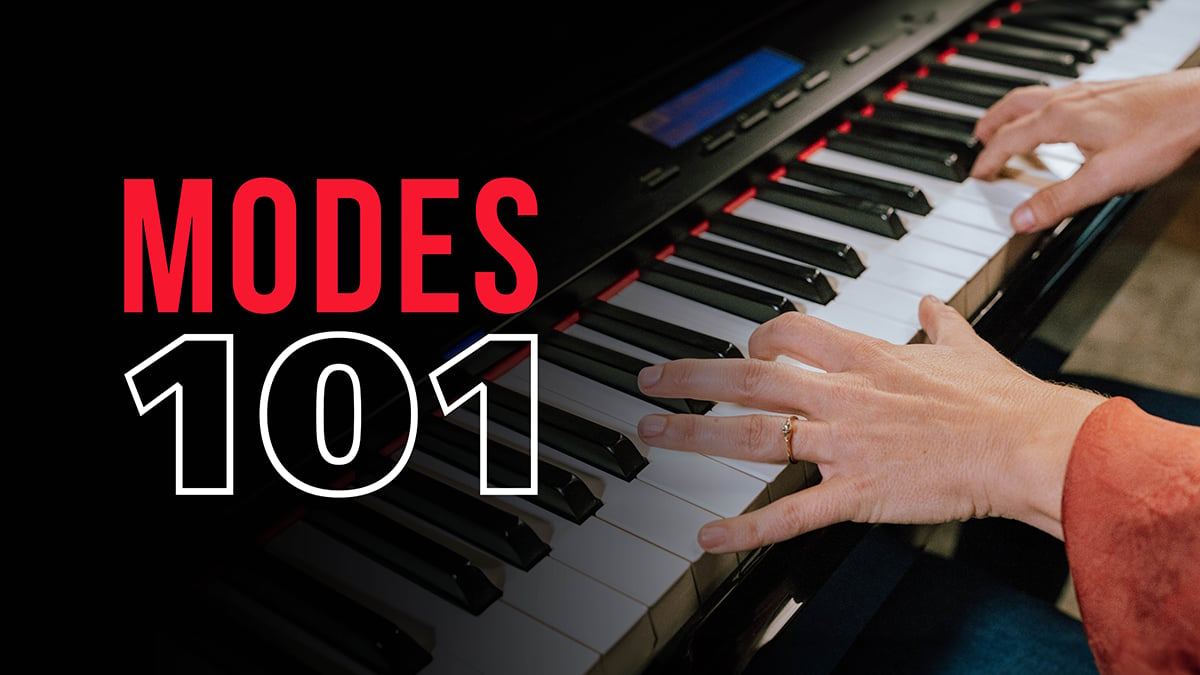
Modes. Just saying the word makes plenty of music students run for the hills. But modes don’t have to be confusing; they can be explained in several ways and they’re super useful, especially if you play jazz and/or want to improvise. In this lesson, we’ll explain what are modes in music in simple language. And we hope you walk away excited about modes—because they’re pretty neat!
Table of Contents:
Get exclusive interviews, fascinating articles, and inspiring lessons delivered straight to your inbox. Unsubscribe at any time
By signing up you’ll also receive our ongoing free lessons and special offers. Don’t worry, we value your privacy and you can unsubscribe at any time.
Okay, so what are modes in the first place? You may have heard of modes explained alongside scales, and the two concepts are closely related. In short:
This might make more sense with examples. So, let’s take C major.
The C major scale…
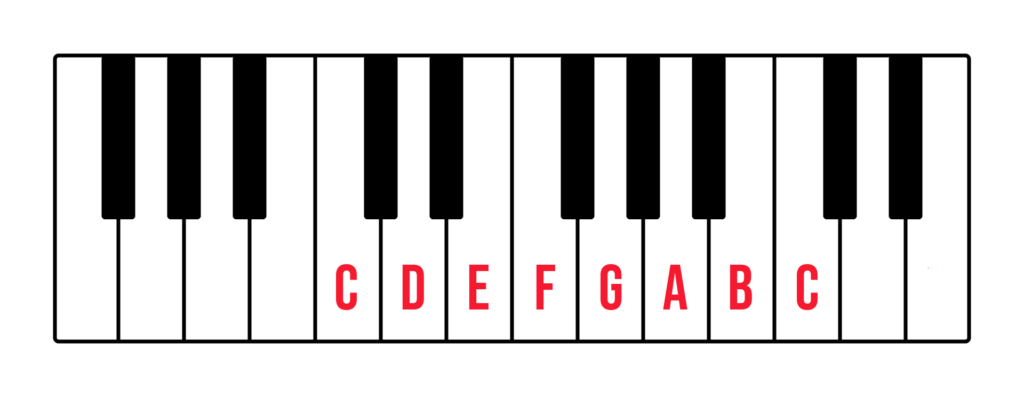
The Dorian mode…
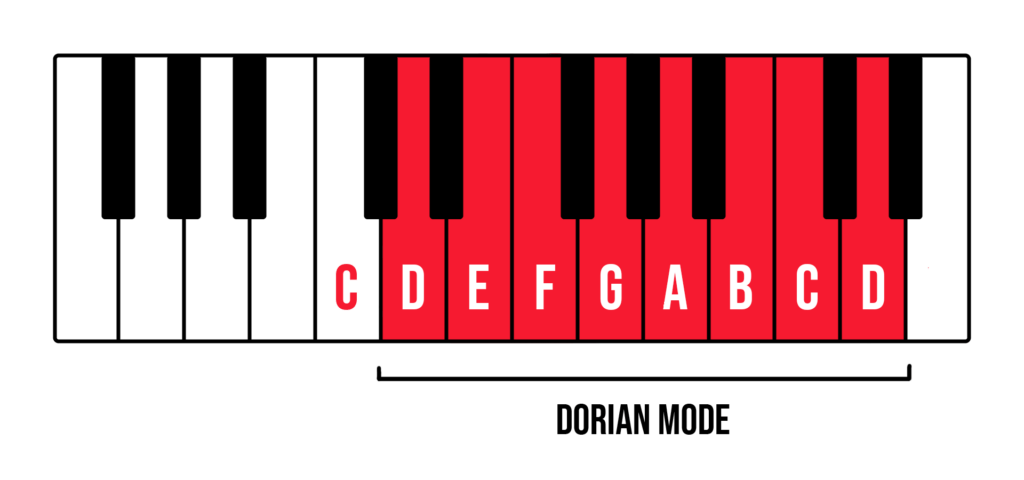
Here’s a table of the seven modes understood in the context of C major. Notice that each mode is named after the first note that appears in its sequence, followed by a Greek name.
| Mode | Notes |
|---|---|
| C Ionian | C-D-E-F-G-A-B-C |
| D Dorian | D-E-F-G-A-B-C-D |
| E Phrygian | E-F-G-A-B-C-D-E |
| F Lydian | F-G-A-B-C-D-E-F |
| G Mixolydian | G-A-B-C-D-E-F-G |
| A Aeolian | A-B-C-D-E-F-G-A |
| B Locrian | B-C-D-E-F-G-A-B |
This is what modes are in a nutshell. If you’re lost, consider reviewing scale and chord concepts with these lessons:
It’s important to know that modes can be understood in a number of ways, depending on what you’re doing.
In the first section, we described modes as different ways (“modes”!) to play a scale. Because there are seven notes in the C major scale, there are seven ways (“modes”!) to play that scale because we can start and end on any of those notes.
Knowing this, say you are given this mode: D Mixolydian. How do we play this mode?
Since the name of this mode is “D” Mixolydian, we know that we’ll start and end the sequence on D. Easy!
But what about “Mixolydian”? Scroll back to the table in the previous section and count: you’ll see that Mixolydian is the fifth mode. This means we should treat D as the fifth note of a parent scale.
In which scale is D the fifth note? If you answered G major, that’s correct! This means we’ll use G major’s key signature in our D-to-D sequence. If you did this all correctly, you’ll land on this:
D Mixolydian Mode
D-E-F#-G-A-B-C-D
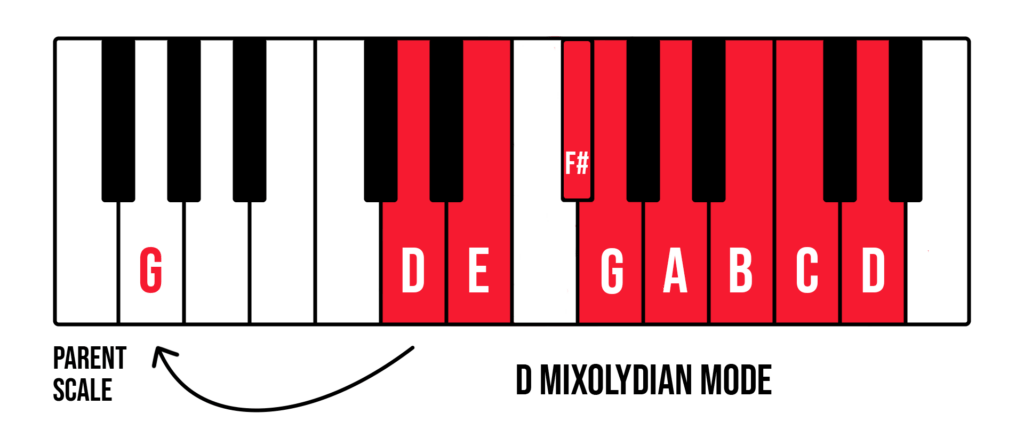
The parent scale method is easy to understand, but it’s less useful when playing music in real-time. If you’re faced with “E-flat Lydian” or “C Locrian,” it can be time-consuming to calculate what notes to play using the parent scale method.
Some musicians believe you should understand modes as alterations made to a major scale. For example, see “C Mixolydian” as “how do we alter the degrees of the C major scale” rather than “what is C Mixolydian’s parent scale’s key signature.” This method keeps you mentally situated on “C” as the tonal center or first note of the sequence, which is where you want to be when improvising.
| Mode | Alterations to Scale | Notes |
| C Ionian | 1-2-3-4-5-6-7-1 No alterations. Same thing as the major scale. | C-D-E-F-G-A-B-C |
| C Dorian | 1-2-b3-4-5-6-b7-1 | C-D-Eb-F-G-A-Bb-C |
| C Phrygian | 1-b2-b3-4-5-b6-b7-1 | C-Db-Eb-F-G-Ab-Bb-C |
| C Lydian | 1-2-3-#4-5-6-7-1 | C-D-E-F#-G-A-B-C |
| C Mixolydian | 1-2-3-4-5-6-b7-1 | C-D-E-F-G-A-Bb-C |
| C Aeolian | 1-2-b3-4-5-b6-b7-1 Same thing as the natural minor scale. | C-D-Eb-F-G-Ab-Bb-C |
| C Locrian | 1-b2-b3-4-b5-b6-b7-1 | C-Db-Eb-F-Gb-Ab-Bb-C |
Which method is better? That’s largely up to you. If you’re already super familiar with keys and key signatures (looking at you, classical pianists!), understanding modes using the parent scale method may be quicker.
But if you’re coming at scales fresh, or don’t mind memorizing, the altered scale method may be right for you. Jazz musicians may find this method more helpful in the context of improvisation.
So, what are modes used for, anyway? Why go through the trouble of memorizing all these funny words and formulas?!
Well, modes can be useful when improvising over chords.
Let’s take a look at the chord-scale relationship.
Scales and chords are actually kind of the same thing! Take the C major triad, for example: C-E-G. Now, stack another third to get the Cmaj7 chord: C-E-G-B.
Then, stack another third, and another third… And soon, you’ve stacked all the notes of C major into one chord:
Cmaj13 = C-E-G-B-D-F-A ← All the notes of the C major scale!
In other words, you can safely play any combination of notes from the C major scale over the Cmaj13 chord. And if you see a Cmaj13 on a lead sheet, you can think to yourself, “Oh, I can play C major over this.”
The same concept can be applied to modes. You can play certain modes over certain chords that are similar to them. And this is a handy way to always sound good.
A good example is C7 (C-E-G-Bb). What mode has these notes? If you answered C Mixolydian, you’re correct! C Mixolydian has a flat 7th (Bb) which makes it fit nicely with a C7 chord.
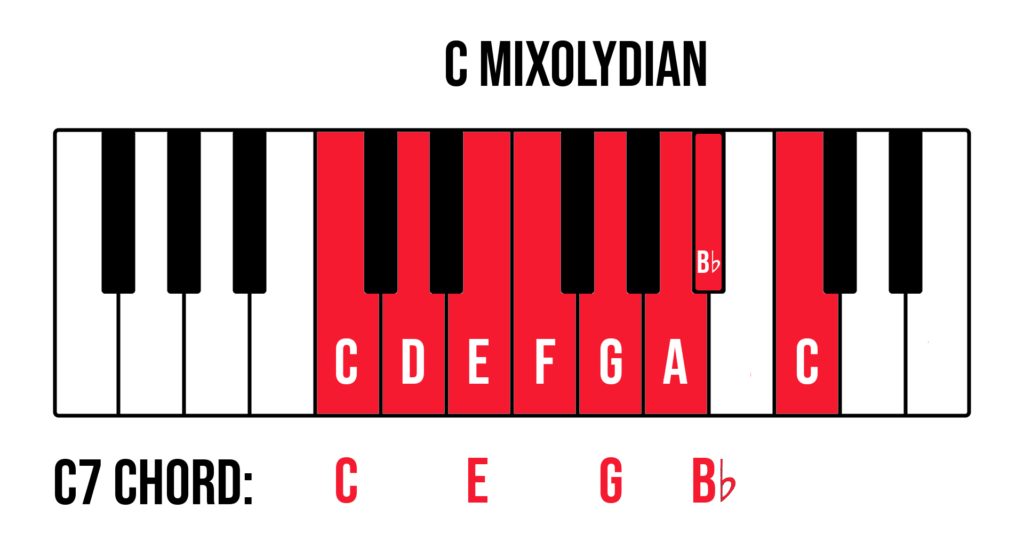
Here are some modes that go well with certain chords. See if you can find what they have in common.
| Mode | Notes (Play these…) | Chords (…over these!) |
|---|---|---|
| C Ionian | C-D-E-F-G-A-B | C, C6, Cmaj7, Cmaj9, Cmaj11, Cmaj13 |
| C Dorian | C-D-Eb-F-G-A-Bb | Cm, Cm6, Cm7, Cm9, Cm11, Cm13 |
| C Phrygian | C-Db-Eb-F-G-Ab-Bb | Cm, Cmb6, Cm7, Db/C |
| C Lydian | C-D-E-F#-G-A-B | C, Cmaj6, Cmaj7, Cmaj9, Cmaj#11, Cmaj13#11, D7/C |
| C Mixolydian | C-D-E-F-G-A-Bb | C, C6, C7, C9, C11, C13 |
| C Aeolian | C-D-Eb-F-G-Ab-Bb | Cm, Cm7, Cm9, Cm11 |
| C Locrian | C-Db-Eb-F-Gb-Ab-Bb | Cm7b5, Db/C, Cdim |
If you know your modes well, you can use them to solo over chord progressions. Try playing these modes over this jazz progression:
| Chord | Modes |
|---|---|
| Dm7 | D Dorian, D Phrygian, D Aeolian |
| G7 | G Mixolydian |
| Cmaj7 | C Ionian, C Lydian |
Modes serve another purpose: mood. Each mode has a distinct flavor and songwriters take advantage of this to convey unique atmospheres with their songs. For example, Lydian is associated with a “bright” and “pretty” sound. Meanwhile, Phrygian and Dorian are “darker.” Locrian is a bit of an odd mode; thanks to its association with diminished chords, it sounds rather sinister.
Modes can be found all over pop music. Here are some song examples of each mode. Listen to these songs to get a sense of the mode’s mood.
| Mode | Song |
|---|---|
| Ionian | “Let It Be” by the Beatles and lots of other songs. |
| Dorian | “Mad World” by Tears for Fears |
| Phrygian | “HUMBLE.” by Kendrick Lamar |
| Lydian | “Yoda’s Theme” by John Williams |
| Mixolydian | “Clocks” by Coldplay |
| Aeolian | “Californication” by Red Hot Chili Peppers and lots of other songs. |
| Locrian | “Army of Me” by Björk |
These song suggestions are thanks to our friend David Bennett, who makes awesome music theory videos on YouTube. He’s made a video about songs in each mode. Check them out!
We hope this clears up your understanding of modes. If you’d like more guidance with your music journey, consider becoming a Pianote Member. You’ll get coached by real teachers and world-class pianists. And you can take guitar, drum, and vocal lessons too!
Your musical journey starts today: try Pianote and get access to drum, vocal, and guitar lessons too!
Pianote is the Ultimate Online Piano Lessons Experience™. Learn at your own pace, get expert lessons from real teachers and world-class pianists, and join a community of supportive piano players. Learn more about becoming a Member.


By signing up you’ll also receive our ongoing free lessons and special offers. Don’t worry, we value your privacy and you can unsubscribe at any time.
We use cookies for traffic data and advertising. Cookie Policy »